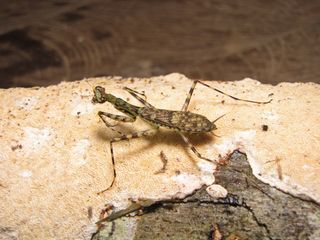19 New Swift & Clever Praying Mantises Discovered

Swift, deadly hunters lurk in the trees, many camouflaged to look like lichen or bark. They don't sit and wait for prey; they actively pursue it. And when danger threatens, some even leap to the forest floor, fluttering to the ground like so many dead leaves.
That's the life of 19 new praying mantis species discovered in Central and South America. The findings, announced today (March 18) in the journal ZooKeys, suggest the world of praying mantis diversity is largely mysterious.
"Based on this study, we can predict that mantis groups with similar habitat specialization in Africa, Asia and Australia will also be far more diverse than what is currently known," study researcher Gavin Svenson, an invertebrate zoologist at The Cleveland Museum of Natural History, said in a statement.
Svenson discovered the new mantises, part of a group called bark mantises, in museum collections and in tropical forests. The continued existence of some of the species is unknown; some are known only from specimens collected 60 years ago, before agriculture or development encroached on habitat. [6 Strange Species Discovered in Museums]
Neotropical bark mantises live on tree branches and tree trunks, Svenson said. They're fleet of foot, dashing around tree trunks like lizards when spotted. The mantises have flattened, mottled bodies that mimic bark, moss, lichen or dead leaves. They fly poorly, so their last line of escape is to leap to the ground and blend in with the detritus on the forest floor.
The 19 newfound species triple the previously known diversity of this group. Researchers once thought a few species colonized wide areas of territory. Now, it seems that, instead, many species have a smaller patchwork of ranges.
Several of the species take science notables as their namesakes. Liturgusa algorei is named after former vice president Al Gore in honor of his environmental activism. Liturgusa krattorum gets its name from Martin and Chris Kratt, who create children's programs on biology. Liturgusa fossetti honors James Stephen Fossett, an aviator and explorer who died in an air crash in 2007. Finally, Liturgusa bororum honors the native Bora people of the Amazon basin.
Sign up for the Live Science daily newsletter now
Get the world’s most fascinating discoveries delivered straight to your inbox.
Svenson also brought a personal touch to describing the new species: He named two of the mantises, Liturgusa tessae and Liturgusa zoeae, after his daughters Tessa and Zoey.
Follow Stephanie Pappas on Twitter and Google+. Follow us @livescience, Facebook & Google+. Original article on Live Science.

Stephanie Pappas is a contributing writer for Live Science, covering topics ranging from geoscience to archaeology to the human brain and behavior. She was previously a senior writer for Live Science but is now a freelancer based in Denver, Colorado, and regularly contributes to Scientific American and The Monitor, the monthly magazine of the American Psychological Association. Stephanie received a bachelor's degree in psychology from the University of South Carolina and a graduate certificate in science communication from the University of California, Santa Cruz.
Most Popular

